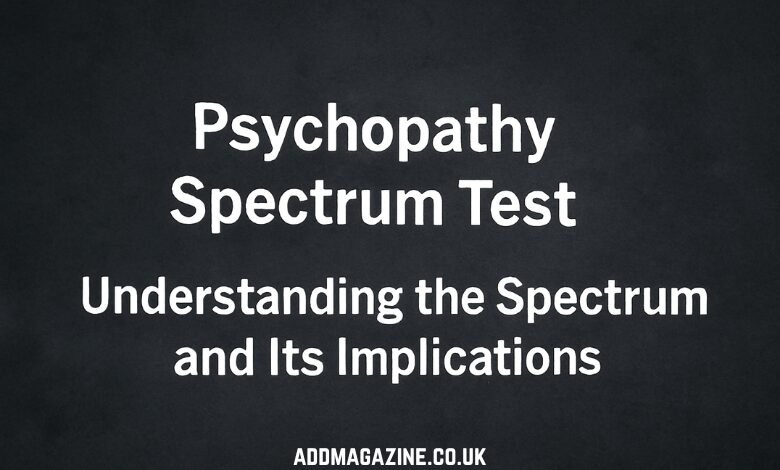Psychopathy has long been a topic of fascination and concern in both psychological research and popular culture. Often portrayed in movies and media as the hallmark of dangerous criminals, psychopathy is far more complex than the simple portrayal of a “villain.” In psychological terms, psychopathy refers to a specific set of personality traits and behaviors characterized by persistent antisocial behavior, lack of empathy, manipulativeness, and boldness.
To understand psychopathy in its full complexity, researchers have developed various tools and frameworks, one of which is the psychopathy spectrum test. This test aims to evaluate an individual’s traits associated with psychopathy, acknowledging that these traits exist along a spectrum. Rather than viewing psychopathy as an all-or-nothing condition, the spectrum approach suggests that individuals can exhibit varying degrees of psychopathic traits.
In this post, we will explore what the psychopathy spectrum test is, how it works, and the implications of using such a tool. We will also discuss its applications, its limitations, and why it matters for individuals and society.
What is the Psychopathy Spectrum Test?
The psychopathy spectrum test is a tool used to assess an individual’s likelihood of possessing psychopathic traits. It is based on the concept that psychopathy is not a binary condition but exists on a spectrum. People can display psychopathic traits to varying degrees, and these traits can manifest in different ways.
The test is typically used by mental health professionals to measure traits such as impulsivity, lack of empathy, superficial charm, manipulativeness, and aggression. It helps to identify individuals who may have psychopathic tendencies, regardless of whether they fit the full clinical diagnosis of Antisocial Personality Disorder (ASPD), which is often associated with more severe cases of psychopathy.
Key Components of the Psychopathy Spectrum
Psychopathy has been studied extensively over the years, and various models have been proposed to understand its nature. The most widely known model is the Hare Psychopathy Checklist-Revised (PCL-R), developed by Dr. Robert Hare. This checklist is used to diagnose psychopathy and is often considered the “gold standard” in psychopathy assessment. However, the psychopathy spectrum test is less rigid and focuses more on a continuous range of psychopathic traits, rather than a strict diagnostic tool.
There are several key components commonly assessed in a psychopathy spectrum test:
Interpersonal Traits
This refers to how individuals interact with others. Traits like superficial charm, manipulativeness, and deceitfulness are often examined. People who score high in this category may be very skilled at making others feel comfortable while having ulterior motives.
Affective Traits
This includes emotional detachment, lack of empathy, and an inability to form meaningful connections with others. Those who display these traits may have difficulty understanding or caring about the emotions of others, which can lead to harmful behavior.
Lifestyle Traits
Individuals high in this trait often engage in impulsive behaviors, seek excitement, and have a disregard for social norms or the law. Their tendency to engage in risky activities and disregard for long-term consequences are markers of this trait.
Antisocial Traits
This aspect of psychopathy relates to behaviors that are overtly criminal or violate the rights of others. It includes aggression, violence, and other acts that harm others for personal gain or pleasure.
Boldness and Risk-Taking
Psychopaths tend to have a high tolerance for risk and fearlessness. They are often seen as being more daring than the average person, which can lead to either successful endeavors or destructive behavior, depending on the circumstances.
How the Psychopathy Spectrum Test Works
The psychopathy spectrum test typically involves a combination of self-reported questionnaires, clinical evaluations, and sometimes external observations. Some well-known tests that are commonly used include the Self-Report Psychopathy Scale (SRP) and the Levenson Self-Report Psychopathy Scale (LSRP). These tests rely on a series of statements or questions that ask individuals to rate how strongly certain behaviors or traits apply to them.
A typical psychopathy spectrum test might involve a set of statements like:
- “I enjoy manipulating others to get what I want.”
- “I often feel no remorse for my actions.”
- “I take risks without considering the consequences.”
The individual is then asked to rate how much they agree or disagree with these statements, providing insight into their psychopathic tendencies.
Applications of the Psychopathy Spectrum Test
The psychopathy spectrum test has several practical applications, ranging from clinical assessments to legal and forensic evaluations. Here are some of the key areas where this test is used:
Clinical Diagnosis and Treatment
Mental health professionals use the psychopathy spectrum test as part of a broader diagnostic evaluation to understand an individual’s personality traits. It can help identify whether someone exhibits psychopathic tendencies, allowing for more accurate treatment planning and intervention. Understanding where an individual falls on the psychopathy spectrum can also help in determining appropriate therapeutic approaches.
Forensic Psychology
In legal settings, the psychopathy spectrum test is used to assess individuals involved in criminal behavior. Psychopathy is often associated with violent crime, but not all individuals with psychopathic traits engage in illegal activities. However, understanding the degree to which someone exhibits psychopathic traits can help assess their risk of reoffending and influence sentencing or rehabilitation recommendations.
Personality and Behavioral Research
Researchers in psychology and psychiatry use psychopathy spectrum tests to study the nature of psychopathy and its relationship to other personality disorders or mental health conditions. It can help build a more nuanced understanding of psychopathy’s role in various contexts.
Corporate and Organizational Psychology
While it may seem unlikely, psychopathy can also be observed in business settings. Some high-ranking executives or professionals may display certain psychopathic traits, such as ruthlessness, manipulativeness, or a lack of empathy, without necessarily engaging in criminal behavior. Understanding psychopathy in the workplace can help organizations better manage leadership styles, ethical issues, and corporate dynamics.
Limitations and Criticisms of the Psychopathy Spectrum Test
While the psychopathy spectrum test can offer valuable insights, it is not without its limitations. One of the primary criticisms is that these tests are often self-reported, meaning that individuals may downplay or exaggerate their behaviors to fit a certain narrative. In cases where individuals are motivated to present themselves in a favorable light (for example, in a job interview or clinical assessment), the results of the test may not fully reflect their true personality.
Additionally, the psychopathy spectrum test cannot definitively diagnose psychopathy. Psychopathy is a complex and multifaceted condition that requires a comprehensive evaluation by a trained professional. The test may indicate a high likelihood of psychopathic traits, but it cannot provide a full diagnosis without further clinical assessment.
There is also the risk of overpathologizing certain behaviors. Traits such as boldness or risk-taking, which are part of the psychopathy spectrum, are not inherently negative. In some cases, these traits may be advantageous, especially in competitive or high-pressure environments. It’s essential to take into account the context in which these traits are displayed.
Conclusion
The psychopathy spectrum test provides a valuable tool for understanding the varying degrees of psychopathy that can exist within individuals. It helps to break away from the traditional notion of psychopathy as an all-or-nothing condition and allows for a more nuanced view of human personality. While it has practical applications in clinical, forensic, and research settings, it is important to remember that the test is only one piece of the puzzle. Psychopathy is a complex condition, and the psychopathy spectrum test is best used as part of a broader evaluation by trained professionals.
By better understanding the spectrum of psychopathy, we can gain deeper insights into human behavior, both the destructive and the constructive, and make more informed decisions about treatment, management, and intervention. It is essential that we approach psychopathy with a balanced view, acknowledging the spectrum of traits while considering the individual context and broader societal factors.




